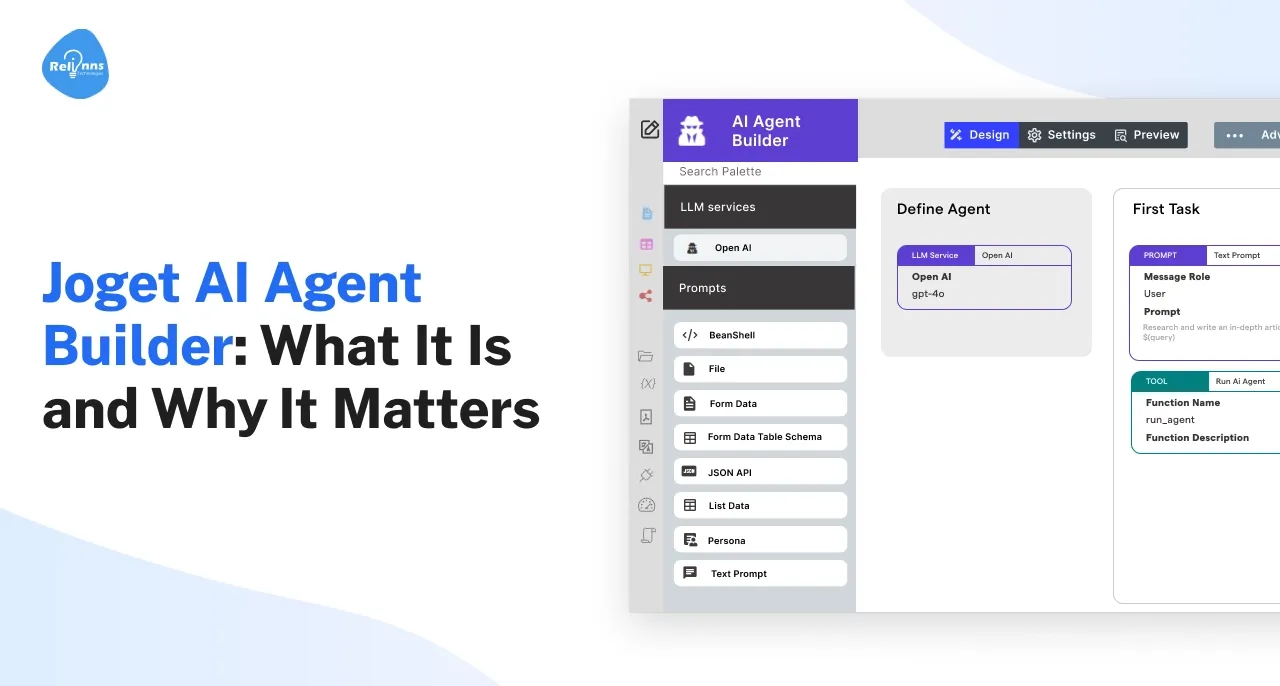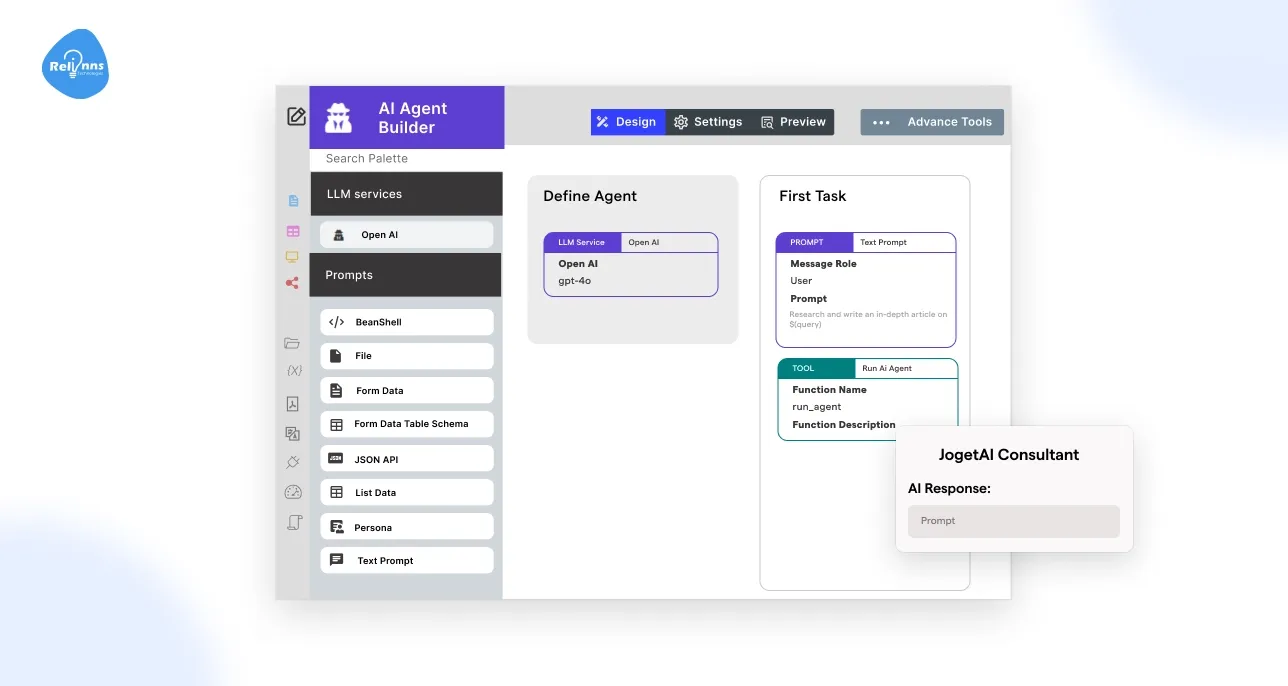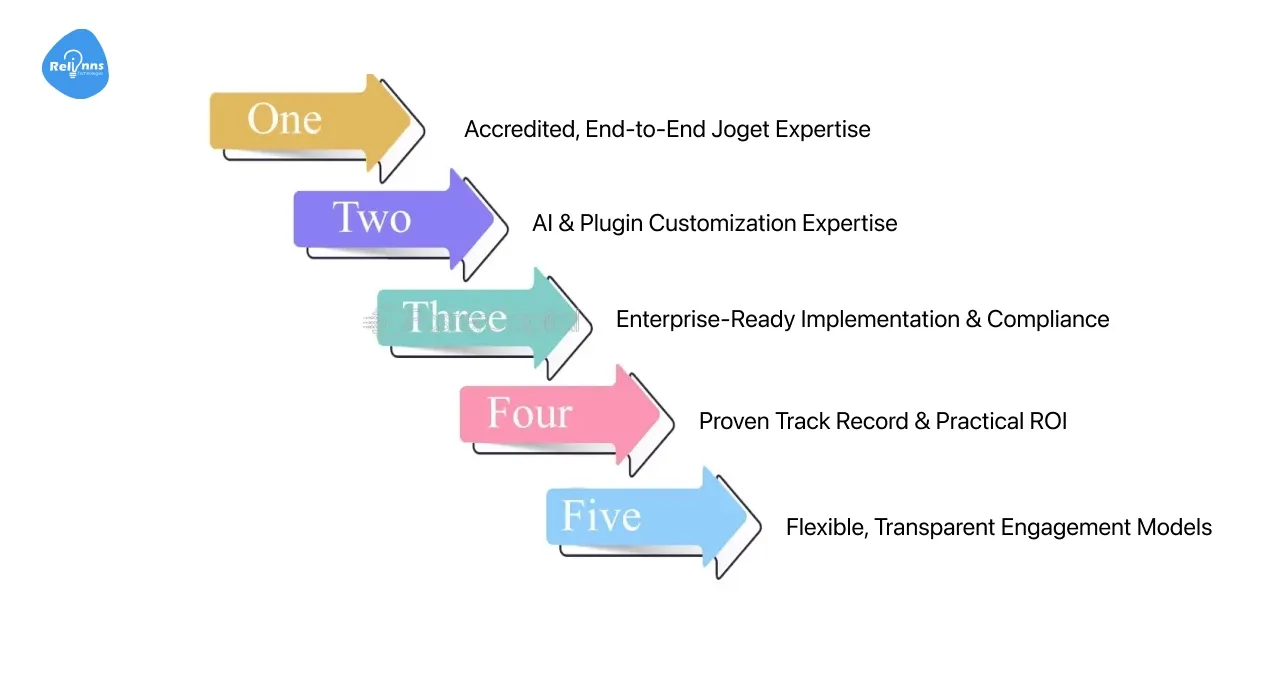Joget AI Agent Builder: What It Is and Why It Matters
Date
Aug 29, 25
Reading Time
9 Minutes
Category
Generative AI

AI is reshaping how businesses build, deploy, and manage applications, and 2025 marks a turning point with Joget AI Agent Builder at the center of this change.
Designed for low-code and no-code environments, it empowers teams to create Agentic AI Systems that automate complex workflows, streamline decision-making, and deliver faster outcomes.
By blending LLMs, AI Agent Tasks, and visual development, Joget makes AI adoption accessible to both technical and non-technical users.
In this article, we’ll explain what the Joget AI Agent Builder is, how it works, its key features, and its future potential. Let’s dig in.
What is Joget AI Agent Builder, and how does it work?
The Joget AI Agent Builder is a low-code/no-code plugin that enables teams to design and deploy AI agents using a visual, drag-and-drop interface—eliminating the need for heavy coding.
You define the agent, choose the LLM (currently supports OpenAI GPT), and configure step-by-step AI Agent Tasks that run in sequence.
Each task can include three components, executed in order: Prompt → Tool → Enhancer.
- Prompt: The instruction sent to the LLM (e.g., “summarize this,” “generate an email reply”).
- Tool: External action performed based on LLM output—like executing a web search, querying a database, or calling an API.
- Enhancer: Post-processes or stores the output, such as saving results into a form or process variable, or manipulating data.
You can preview and debug agents before going live, then embed them into Joget apps and workflows using the AI Agent Tool for process activities, keeping human-in-the-loop control.
Joget AI Agent Builder Online: Setup and Access
The AI Agent Builder plugin is available for download from the Joget Marketplace and supports Joget DX 8.1.0 and later versions (Enterprise). You’ll need an LLM API key (e.g., OpenAI). Create a test agent in a non-production app first so experiments don’t affect live users.
TL;DR: define the agent + LLM, add sequential tasks with prompts/tools/enhancers, test in Preview, and run it inside your Joget workflows.
Joget AI Agent Builder Tutorial: Step-by-Step Guide
Setup and installation are covered above; skip them. Begin here to implement the agent with tasks, tools, enhancers, testing, governance, deployment.
Create a new agent and add an LLM service with default instructions
- Pick the model and (where available) configure parameters like temperature and max tokens.
- Write a concise system instruction defining scope, tone, constraints.
- Add guardrails (forbidden topics, max output length).
Add tasks in sequence; keep each task focused on one outcome
- Name tasks clearly (e.g., Collect Input → Summarize → Notify).
- One integration per task simplifies debugging.
- Follow the familiar Prompt → Tool → Enhancer pattern.
Configure inputs for stable prompts
- Prefer Form Data or JSON mappings over free text.
- Validate file types, size limits, and required fields before execution.
- Map outputs to process variables you’ll reuse later.
Attach tools for APIs, email, searches, or nested agent calls
- Start with JSON API, Email, Web Search, Beanshell, or Run Agent.
- Add timeouts, retries, and auth headers; keep secrets out of prompts.
- Mock external endpoints in development.
Add enhancers to format, store, or transform outputs
- Normalize results to a JSON schema; extract key fields.
- Save to forms/process variables; generate summaries or artifacts (e.g., CSV, PDF) as needed.
- Log all necessary fields for audit and troubleshooting purposes.
Use Preview to test inputs, review payloads, and refine behavior
- Create realistic test cases and run them repeatedly.
- Inspect request/response payloads, token usage, and latency.
- Verify error paths and retry behavior for each external call.
- Tweak instructions, parameters, and stop sequences based on results.
Add guardrails and governance before go-live
- Role-based permissions, PII masking, output limits.
- Centralized logging with trace IDs; version labels and change notes.
- Define fallbacks to manual handling when external calls fail.
Embed the agent in a Process Builder workflow and add human review steps
- Place the AI Agent Tool at the right stage.
- Add an approval step after high-risk actions.
- Define SLAs, escalations, and clear failure paths.
Deploy safely through staging to production
- Promote from sandbox; tag the release and archive older versions.
- Enable alerts for error rate, latency, and cost per run.
- Define a rollback trigger (e.g., error rate > X% across N runs).
Measure outcomes and optimize
- Track time saved, first-pass accuracy, and cost per transaction.
- Track one business KPI (e.g., turnaround time, SLA adherence, resolution rate).
- A/B test prompts or task ordering.
- Consolidate or split steps based on actual log data.
Reuse and modularize
- Package standard capabilities as sub-agents via the Run Agent feature.
- Create templates with prefilled instructions and schemas.
- Share naming conventions and a brief runbook with your team.
Tip: Start narrow (e.g., “summarize an uploaded contract and email a draft to legal”), stabilize the core flow, then add integrations.
What features define Joget AI Agent Builder?

The Joget AI Agent Builder stands out with a blend of powerful, user-friendly features, designed to make AI agent development accessible, fast, and deeply integrated into enterprise workflows:
- Visual, drag‑and‑drop interface: Built on Joget’s low-code philosophy, the AI Agent Builder mirrors the intuitive Form Builder; anyone, regardless of coding background, can define agents visually.
- Agent structure with LLM selection: You start by setting up the agent’s “brain”. Then, select an LLM such as GPT and define default prompts or instructions.
- Task-based sequential workflow
- Each AI agent is built as a series of AI Agent Tasks, executed in order.
- Each task comprises three optional components: Prompt → Tool → Enhancer.
- Preview and debugging tools: You can test agents using a built-in Preview tab, which simulates real-world use cases, allows you to inspect payloads, refine prompt behavior, and debug flows before deployment.
- Seamless workflow integration
- Agents created in the Builder can be embedded into Joget apps via the AI Agent Tool in Process Builder workflows.
- This maintains human oversight through review or approval steps where needed.
Enterprise-Ready Setup: The Builder supports multi-user collaboration, version control for AI agents, and centralized governance dashboards. This ensures large teams can manage permissions, track changes, and maintain compliance across departments without losing agility.
These features make the Joget AI Agent Builder Plugin a powerful tool for building Agentic AI Systems, adding intelligence, automation, and human-centered control directly into business processes across departments.
What is the future of Joget AI Agent Builder?

The Joget AI Agent Builder is rapidly evolving as a key part of the broader Joget Intelligence ecosystem in Joget DX 9, transforming from a standalone plugin into a seamless AI-driven development suite.
Expansion within Joget Intelligence
Joget DX 9 now frames AI capabilities under the Joget Intelligence umbrella, alongside:
- Joget AI Designer: Generates apps from text or images in an intuitive way.
- AI Agent Builder: Orchestrates autonomous, agentic workflows.
- Joget AI Bundle: A suite of AI plugins (e.g., TensorFlow) for advanced use cases.
- Joget AI Assistant: Embedded UI assistant for smart insights and support in the platform.
What’s ahead: Innovation in Integration and Extensibility
Though specific future features for the AI Agent Builder haven’t been officially listed yet, the overall DX 9 roadmap hints at enriching AI capabilities with:
- Better UX and responsiveness.
- Stronger governance, security, and identity controls.
- Deeper integration with third-party systems via API connectors.
- Support for scalable, enterprise-grade deployments.
Open Architecture for AI Model Flexibility
Even now, the Agent Builder supports OpenAI’s models, but its architecture is extensible, paving the way for future support of other LLM providers like Anthropic, Google, or private models.
Strategic Alignment with Low-code + Generative AI Momentum
Joget continues to lean into the synergy between low-code and generative AI. Industry trends suggest that this combination will significantly accelerate adoption, so platforms like Joget, which embed TuringBot-style capabilities, are strongly positioned.
In short, the future of Joget AI Agent Builder lies within a smarter, more unified AI development environment in DX 9. One that combines ease, power, and flexibility. Expect stronger integration with AI Designer, AI Assistant, and Marketplace plugins, robust governance, scalable workflows, and evolving support for AI models.
How does Joget AI Agent Builder use LLMs?
Joget AI Agent Builder uses LLMs as the core engine, turning natural language prompts into intelligent, actionable workflows.
LLMs: The Brain Behind the Agent
- LLM Services power the AI engine of the Joget AI Agent Builder, enabling it to interpret and generate natural language, transforming prompts into meaningful actions. Currently, the Builder supports OpenAI’s GPT models. More providers (e.g., Google, Anthropic, private models) are planned.
- Within the Builder, you explicitly add an LLM service to define the agent’s “brain” and configure its behavior.
How LLMs Power AI Agent Tasks?
- Each agent consists of sequential AI Agent Tasks, with three optional components in order: Prompt → Tool → Enhancer.
- This structure enables LLMs to seamlessly blend intelligence with task-specific logic, thereby bridging the gap between generation and execution.
LLM Models & Configuration
- When using OpenAI’s integration, you can select from models like gpt-3.5-turbo, gpt-4, or the latest gpt-4o, depending on your needs. You’ll need to provide a valid API key to activate the service.
- And thanks to Joget’s extensible architecture, support for additional LLM providers, such as Anthropic or private models, is built into the roadmap.
At its core, the Joget AI Agent Builder leverages LLMs to interpret user intent, generate responses, and trigger workflows, making intelligent automation accessible in a no-code environment.
How AI Agent Builder Tasks and Components Run

Here’s how the Joget AI Agent Builder orchestrates its task execution pipeline in a clean, step-by-step process:
1. Agent Definition & Task Sequencing
You define an AI agent visually, layering multiple AI Agent Tasks in sequence—each representing a distinct step in the workflow (e.g., data fetch, transformation, or response generation). Tasks are processed one after another, ensuring orderly flow control and logic execution.
2. Task Execution Flow
Each task executes a well-defined three-stage flow: Prompt → Tool → Enhancer (with Tool and Enhancer being optional).
- Prompt: The instruction sent to the LLM, such as summarizing, generating, or interpreting data. Joget offers various input options, including text, file, form data, JSON, persona, and more.
- Tool (optional): If defined, the agent then triggers external actions—like running a database query, sending an email, performing a web search, invoking another AI agent, or calling a JSON API. Joget includes tools like Beanshell, Google Web Search, JSON API, Email, and even a “Run Agent” tool for nested agent calls.
- Enhancer (optional): After the AI response, enhancers post-process and store results within Joget, e.g., saving output to a form or process variable, extracting code, or using Beanshell logic.
3. Modular & Reusable Design
With the Run AI Agent Tool, you can invoke another agent within a running workflow. This enables modular agents, simplify complexity by breaking workflows into smaller agents that call each other as needed.
4. Debug & Preview Before Deployment
Within the Builder, there's a Preview tab where you can simulate how your agent behaves, send test inputs, inspect the generated LLM payloads, verify tool calls, and check enhancer outputs, ensuring everything works as intended before going live.
Together, these components make the Joget AI Agent Builder a robust platform for designing agentic AI workflows that can chain tasks, interact with external systems, efficiently handle logic, and undergo thorough testing before deployment.
Why choose Joget AI Agent Builder with a certified partner like Relinns?

Partnering with a certified expert like Relinns transforms the use of Joget AI Agent Builder from a powerful tool into a strategic accelerator for enterprise-grade AI automation.
| Benefit | What It Means for You |
| Joget-certified team | Trusted, high-quality delivery |
| Custom AI & plugin build | Tailored capabilities and smoother integrations |
| Enterprise-grade readiness | Security, compliance, and scalability built in |
| Proven efficiency & ROI | Faster builds, lower costs, tangible results |
| Flexible support models | Fit for various budgets and project scopes |
1. Accredited, End-to-End Joget Expertise
- Official Joget Certified Partner: Relinns Technologies is an accredited Joget partner in India, authorized for software licensing, development, training, and implementation of Joget DX solutions for the period of 2024–2025.
- Full Lifecycle Services: From licensing and training to app architecture, plugin development, and support, Relinns offers consultancy and implementation across every stage of your Joget journey.
2. AI & Plugin Customization Expertise
- Custom Plugin Development: Whether it’s AI capabilities, scheduler logic, security, or integrations, Relinns can build tailored Joget plugins, including ones that harness the power of AI Agent Builder to align precisely with your business needs.
- Specialized AI Agent Integration: With experience in embedding intelligent workflows, they help you seamlessly extend and integrate Agentic AI Systems into your workflows, ensuring that automation is not only functional but also deeply aligned with your logic and governance needs.
3. Enterprise-Ready Implementation & Compliance
- Strong Governance, Security & DevOps: Relinns designs Joget solutions with enterprise concerns in mind—implementing SOC2, HIPAA, GDPR, and other compliance frameworks. They also support DevOps, CI/CD, and scalable deployment practices.
- Multi‑Model Workflows & Scalability: Take complex processes, break them into manageable Joget agents, and orchestrate them into composable workflows, crafted with modularity, reusability, and enterprise-level scaling in mind.
4. Proven Track Record & Practical ROI
- Slash Development Time, Maximize ROI: Working with Relinns, organizations report up to 200% faster development, 70% cost reduction, and delivery of enterprise features up to 50% quicker.
- Real-World Impact: A Qatar-based public sector agency leveraged our’ certified Joget services to build an AI-powered contract management platform in just eight weeks to automate clause detection, compliance checks, and stakeholder access.
5. Flexible, Transparent Engagement Models
- Tailored Collaboration Options: Relinns offers flexible engagement, from hourly hires to fixed projects or full-time offshore teams, making it easy to scale based on your organizational needs.
- Smooth, Secure Delivery: With NDA-backed security protocols, rapid onboarding (developers available in ~48 hours), and remote delivery setups, you get agile execution without risk.
Conclusion
The Joget AI Agent Builder is more than a plugin, it’s a gateway to building Agentic AI Systems that simplify workflows, automate decision-making, and scale with enterprise needs.
By combining LLMs, task sequencing, and visual low-code design, advanced AI becomes accessible to both developers and business teams.
But success with AI agents depends on more than tools, it requires the right implementation partner. As a certified Joget partner, Relinns Technologies delivers expertise in development, customization, and enterprise-grade deployment, ensuring your AI agents are secure, scalable, and driven by ROI.
If your business is ready to embrace intelligent automation in 2025, Relinns can help you unlock the full power of Joget AI Agent Builder.
Frequently Asked Questions (FAQ's)
Where can the Joget AI Agent Builder be applied?
The Joget AI Agent Builder is applicable across customer service, automation, data analysis, and compliance, enabling organizations to create scalable, intelligent workflows that save time and reduce costs.
How does Joget AI Agent Builder ensure oversight?
By embedding human-in-the-loop controls, every AI Agent Task undergoes checks, approvals, and logging. This ensures transparency, accountability, and compliance within enterprise workflows and automated processes.
How do I create my own AI agent?
Install the AI Agent Builder plugin, select your LLM, configure tasks step-by-step, preview results, refine behavior, and embed the agent into Joget workflows.
Why partner with Relinns for Joget AI Agent Builder?
Relinns, a certified Joget partner, delivers expertise in customization, plugin development, and enterprise deployment, ensuring secure, scalable, ROI-driven adoption of the Joget AI Agent Builder plugin.



